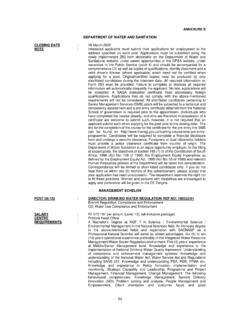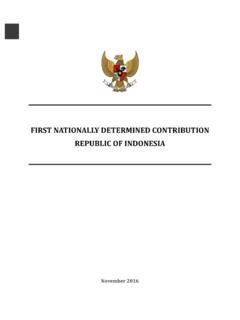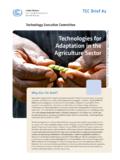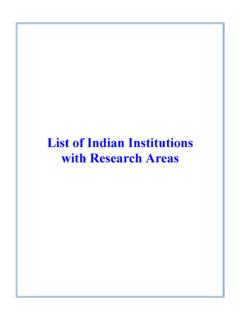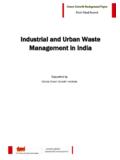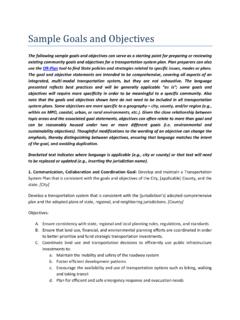Transcription of A STUDY OF CONSTRUCTION MATERIAL WASTE …
1 A STUDY OF CONSTRUCTION MATERIAL WASTE management PRACTICES BY CONSTRUCTION FIRMS IN NIGERIA A. A. Dania, J. O. Kehinde and K. Bala Department of Building, Ahmadu Bello University, Zaria, Kaduna State, 800001 Nigeria Email: Abstract: CONSTRUCTION WASTE management is an aspect of Sustainable Development, which is fuelled by the growing concern for the effect of man s activities on the environment. The management of CONSTRUCTION processes to reduce, reuse, recycle and effectively dispose of wastes has a serious bearing on the final cost, quality, time and impact of the project on the environment. This research studied the practice of CONSTRUCTION MATERIAL WASTE management by firms in Nigeria by the use of structured questionnaires to senior CONSTRUCTION -professional personnel of CONSTRUCTION firms.
2 The STUDY found out that specific Government legislation on wastes from CONSTRUCTION sites were non-existent and that the respondents considered other project goals of timely project delivery, quality and cost as more important than the impact of the project on the environment. Most respondents displayed a poor understanding of WASTE management and most companies did not have a policy on MATERIAL WASTE management . The paper recommends that the Nigerian Government puts in place legislation regarding CONSTRUCTION site WASTE management . Professional bodies and academic institutions in the country should seek to further educate their members on the importance of effective MATERIAL WASTE management strategies.
3 Keywords: CONSTRUCTION WASTE management , Government Legislation, Nigeria, Policy, Sustainable Development. 1. INTRODUCTION The building or CONSTRUCTION industry involves different processes and utilizes huge quantities of resources. These processes have severe impacts on the environment which according to Horsley (2003), occur over a variety of timescales from the extraction and processing of raw materials used in CONSTRUCTION , through the duration of the CONSTRUCTION process, the operation of the building, up to the eventual demolition of the structure at the end of its operative life. CONSTRUCTION activities have been known to generate large and diverse quantities of WASTE .
4 According to the US Green Building Council, (2001), it accounts for up to 30% of total WASTE output in the United States alone, put at about 136 million tons per annum. As a result, CONSTRUCTION and demolition WASTE management has become one of the major environmental problems in many municipalities (Faniran and Caban, 1988; Kibert, 1994; Ferguson et al., 1995; Graham and Smithers, 1996; Guthrie et al., 1999; Symonds, 1999; Lawson and Douglas, 2001, cited in Poon et al, 2004). In some more advanced countries, the concern for the effect of Man s endeavours on the environment and rising project costs has increased the drive for the application of CONSTRUCTION WASTE management . There has been a strong drive to do more with less by reducing WASTE at all stages of CONSTRUCTION as identified by the Rethinking 121 CONSTRUCTION task force in the UK (DETR, 2000).
5 There is also a need to improve MATERIAL handling by contractors as the DETR also noted that about 13 million tonnes of the estimated 70 million tonnes of CONSTRUCTION and demolition materials comprise of materials delivered to site and thrown away unused. The Effect of CONSTRUCTION Activities CONSTRUCTION can be defined as the activity involving creation of physical infrastructure, superstructure, housing and other related facilities (Watuka and Aligula, 2003). The physical substance of a structure is an assembly of materials from widely scattered sources. They undergo different kinds and degrees of processing in large numbers of places, require many types of handling over periods that vary greatly in length, and use the services of a multitude of people organized into many different sorts of business entity.
6 The CONSTRUCTION industry, while contributing to overall socio-economic development of any country, is a major exploiter of natural non-renewable resources and a polluter of the environment whereby it contributes to the environmental degradation through resource depletion, energy consumption air pollution and generation of WASTE in the acquisition of raw materials (Watuka and Aligula, 2003). CONSTRUCTION activities generate a large amount of WASTE compared to other industries. In EC countries, about 200 to 300 million tons of CONSTRUCTION and demolition WASTE is produced annually, which translates to roughly a 400 km2 area covered with demolition debris one meter high (Pieterson and Fraay, 1998, cited in Elias-Ozkan and Duzgunes, 2002).
7 In the United States alone, about 136 million tonnes of CONSTRUCTION WASTE is generated (US Green Building Council, 2001). Sustainable CONSTRUCTION According to Harman and Benjamin, (2004) the built environment is the heart of any economy; providing the infrastructure necessary to enhance productivity, but the manner in which it consumes natural resources makes it responsible for some of the most serious local and global environmental changes. Sustainable CONSTRUCTION is an integrative and holistic process of CONSTRUCTION which aims to restore harmony between the natural and the built environment (Agenda 21, 2001). The California integrated WASTE management Board (2003) described Sustainable CONSTRUCTION as a whole building approach to design and CONSTRUCTION that saves or reduces resources in five categories: site, water , energy, materials and environmental quality.
8 Sustainable CONSTRUCTION , according to Watuka and Aligula (2003) can also be said to be the set of processes by which a profitable and competitive industry delivers built assets: building structures, supporting infrastructure and their immediate surroundings which: i. Enhance the quality of life and offer customer satisfaction ii. Offer flexibility and the potential to cater of user changes in the future iii. Provide and support desirable natural and social environments iv. Maximize the efficient use of resources while minimizing wastage. MATERIAL WASTE in CONSTRUCTION There are differing views held by researchers as to what constitutes CONSTRUCTION WASTE . Cheung, (1993) stated that CONSTRUCTION WASTE can be defined as the by-product generated and removed from CONSTRUCTION , renovation and demolition workplaces or sites of building and civil engineering structures.
9 According to Formoso, (1999), it should be understood as any inefficiency that results in the use of equipment, materials, labour, or capital in larger quantities than those considered necessary in the production of a building. Shen et al,(2003) defined building MATERIAL wastages as the difference between the value of materials delivered and accepted on site and those properly used as specified and accurately measured in the work, after deducting the cost savings of substituted materials transferred elsewhere, in which unnecessary cost and time may be incurred by MATERIAL wastages. Serpell et al, (1995), cited in Alwi et al, (2003) asserted that CONSTRUCTION Managers have to deal with many factors that may negatively affect the CONSTRUCTION process, producing different types of wastes.
10 There are several causes of MATERIAL wastes which in most cases are dependent on the type of CONSTRUCTION methods employed, the specific materials in use, and/or the stage of the CONSTRUCTION itself. WASTE can be generated by mistakes, working out of sequence, redundant activity and movement, delayed or premature inputs and products or services that do not meet customer needs ( CONSTRUCTION Industry Board, 1998). CONSTRUCTION and Demolition WASTE is a complex WASTE stream, made up of a wide variety of materials which are in the form of building debris, rubble, earth, concrete, steel, timber, and mixed site clearance materials, arising from various CONSTRUCTION activities including land excavation or formation, civil and building CONSTRUCTION , site clearance, demolition activities, roadwork, and building renovation.


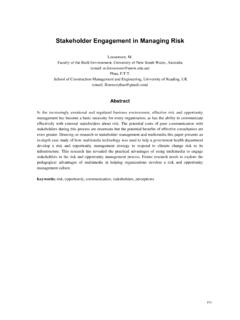





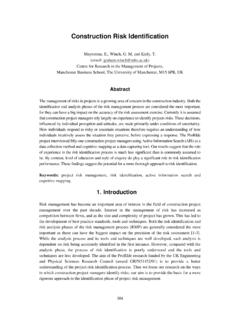
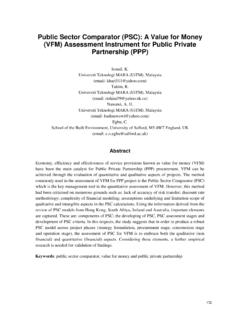
![National Water Act [No. 36 of 1998] - Energy](/cache/preview/a/6/8/e/8/1/4/b/thumb-a68e814b4d9bccc74f62a3a6b561e382.jpg)

